Facades: Beauty Starts Skin Deep
The first chance a building has to make a statement is with its exterior. What that statement is partially depends on the materials and systems used, and how they’re incorporated into the designer’s vision.
![]() Continuing Education
Continuing Education
Use the following learning objectives to focus your study while reading this month’s Continuing Education article.
Learning Objectives - After reading this article, you will be able to:
- Identify and recognize the range of performance requirements of a facade as part of the overall exterior design and building enclosure.
- Assess the design and performance aspects of building facades, particularly related to structure, support, glazing, and specialty integration.
- Explain the integration of facade materials and systems as they relate to energy-efficient and high-performance building design.
- Determine ways to incorporate the principles discussed as related to the design and performance of buildings as shown in case studies.
The facade of a building plays a key role in the overall design perception of a building as well as its ability to perform favorably. As the visible public “face” of a building, it provides a means for design expression that can range from traditional to innovative, planar or three dimensional, static or dynamic, colorful or not. Architectural critics in multiple media platforms expound on the relative merits and deficiencies of particular building facade designs while the general public reacts with vernacular zeal for what it likes or doesn’t like. From a performance standpoint, facades often provide the largest surface area of the building enclosure, thus having a very direct impact on the long-term durability and energy performance of the building. Of course, the particulars of the facade need to be based on the local conditions to respond not only to design preferences but to performance issues as well. The Architecture 2030 organization defines this point by saying, “A climate-based building facade is a filter between exterior and interior that creates comfortable internal living conditions.”1 As such, a facade design determines what filters in (e.g., sunlight, fresh air, etc.) and what is filtered out (e.g., excess heat, noise, etc.) all in the context of good design principles.
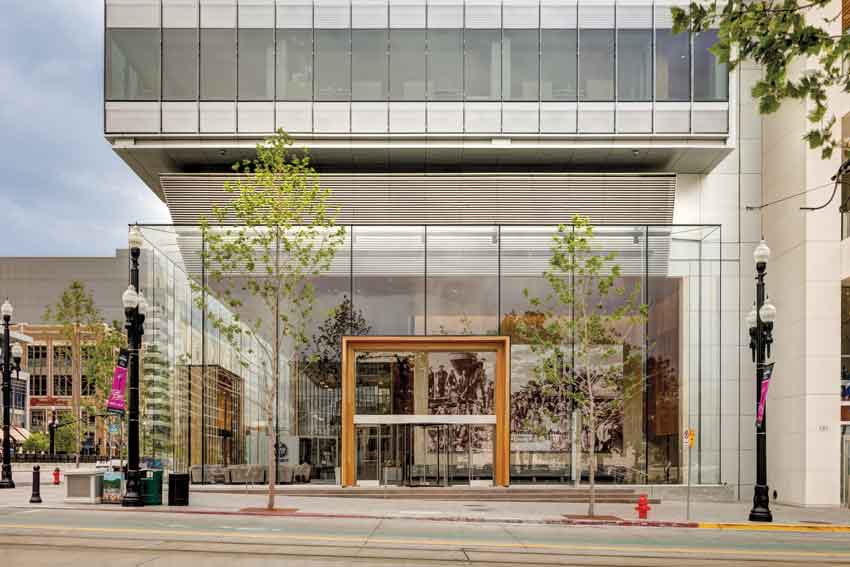
Photo courtesy of Construction Specialties
Building facades are key elements in both the design and performance of a building with many choices available in products, materials, systems, and solutions.
In the quest for a high-performing, well-designed building facade, architects need to rely on their understanding of the plethora of available materials, products, systems, and solutions on the market. In this course, we will look at some of those commonly available choices with an eye toward achieving innovation and high performance in building designs.
Integrating Structure and Facade
In a three-dimensional building exterior, sometimes it is the design intention to connect the inside with the outside, blur the visual sense of the enclosure, and provide daylight and views while still providing shade. By expanding the definition of a facade to encompass the entire outward expression of a building, its exterior form, its extended parts, and overhangs, the aesthetic and architectural value can be enhanced. Interconnected three-dimensional exteriors can provide opportunities for light sources to play with interior spaces, create an artistic continuation of themes from the outside to the inside, and generate overall impressions that delight the users and visitors to a building. Achieving these design results does not need to be elaborate or complicated. In fact, some of the best solutions often rely on simple, elegant design approaches and common building materials. One example that we will explore here is the use of structural steel decking systems to create innovative and high-performing facades.
Horizontal Projections
Steel decking has been used successfully to extend out horizontally past the exterior wall system to create an overhang or other design feature. A range of steel decking systems are available to address both structural and aesthetic objectives. Among these are deep ribbed or “dovetail” shaped steel deck profiles that offer enhanced structural strength plus an attractive pattern on the underside of the deck. When left exposed, this deck becomes integral to the overall aesthetic, whether serving as uniquely designed roof extensions or as integrated screens and canopies. They can also provide acoustical control when used for ceiling applications. Further, they can be longer in their span than standard steel deck, up to 35 feet in many cases. For simplified construction, lighting, electrical, plumbing, and fire suppression can all be readily integrated in the system. Of course, proper detailing is needed to assure thermal bridging is avoided, but that can be very straightforward to achieve.
Cladding
In addition to horizontal uses, vertical, angled, curved, or sloped steel facades can be created using steel roof deck profiles as a cladding material. One of the ways to do this is by using structural steel decking (i.e., found in specification Division 5) for facade cladding in lieu of the typically more expensive architectural metals (i.e., found in specification Division 7). The attachment and field installation processes are well known and can produce a consistent, controlled performance related to loading conditions. Further, the appearance can hold up well over time. It should not be a surprise, then, to realize that this steel decking is being used not only for the underside of horizontal canopies on building exteriors but also for vertical facades.
Such structural steel decking is engineered for strength and durability and comes in a variety of profile shapes and depths with a range of visual effects. These include dramatic deep flutes, ribbed patterns, a lineal plank appearance, or a clean, smooth look. When used as cladding, steel decking can uniquely address the facade objectives of function, form, and cost control. This comes about because these systems contribute both structurally as well as aesthetically to the building. They serve to transfer loads and forces into the main building structure to maintain the integrity of the building while helping to weatherproof the exterior—and they can provide the finished cladding surface all in one product.
Standard profile deck along with long-span deck can be readily installed vertically, minimizing joint lines and creating an attractive exterior cladding. The engineered corrugations in the decking can be sized to hold up against wind, weather, and usage as appropriate to the project location, making it suitable for a permanent or sacrificial skin or a rainscreen on a facade. It can also serve as a sun screen or solar shading device where appropriate.
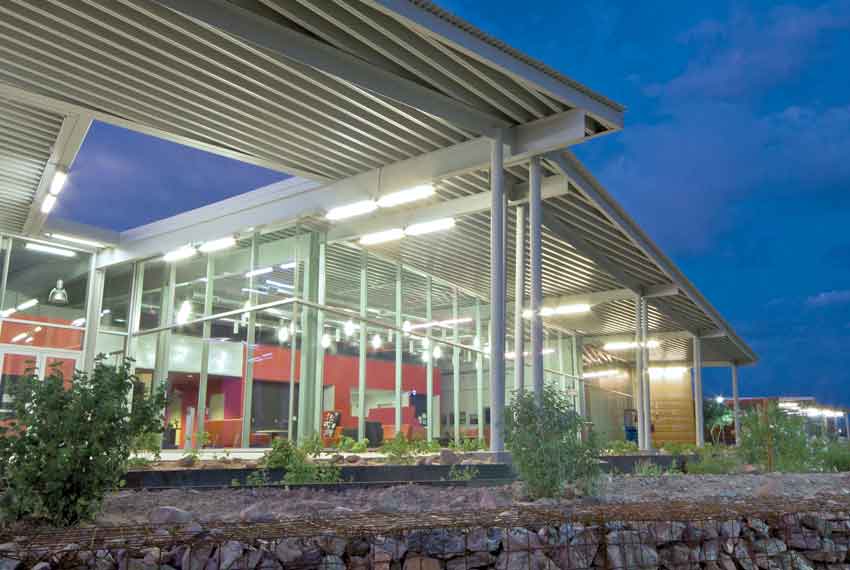
Photo courtesy of New Millennium Building Systems
While the facade of this education facility is a window wall, the windows, ceilings, and roof extensions become the “face” of building. The deep ribbed, non-acoustical roof deck seamlessly flows to the interior, where it is factory installed with acoustical mitigation. Both are surface finished at the factory.
Finished Appearance
One of the aspects of using steel decking either for roof/ceiling designs or cladding is the ability to conceal the fasteners. This helps with the overall appearance of the system but also helps assure greater weathertightness. With an uninterrupted surface to work with, the exposed surface of the deck system can be coated or textured to suit a variety of design needs. Steel deck is typically galvanized, but there are also options for variations like using stainless steel. Coatings can also be introduced to contribute to the durability of the material and longevity of the facade. Such coatings can be used to provide statements of color and texture that give a building its visual personality.
Recognizing the suitability of steel deck in exposed exterior locations, manufacturers offer a range of prefinished options using a variety of coatings. If primer and paint are factory applied on galvanized steel, it can provide years of protection that outlasts other options to keep the material looking good longer. This can be true even in aggressive environments, like swimming pools with corrosive chlorine, saline climates, or areas of high humidity. They are also effective at handling extreme environments such as marine locations and full ultraviolet exposures. Even in these situations, the prefinished coating systems can carry warranties and withstand chalking and fading over the years.
These prefinished products also give architects a broader design palette, allowing color, pattern, and texture to be selected to suit particular aesthetics. Regardless of the final look, these new prefinished deck options eliminate on-site painting or finishing, thus saving time during the construction process. The prefinishing also helps to assure a consistent and uniform appearance.
Building Applications
Steel decking systems used in facades are often considerably less costly when properly evaluated from the standpoint of total cost to a project. This makes them attractive not only for their design and performance characteristics but also for their ability to address project budgets. As such, architectural steel decking is increasingly being used as ceiling and cladding solutions for such applications as stadium exteriors and roofs, natatorium ceilings, open-air walkways, screens, and canopies. They are also being used in higher education and other commercial and institutional buildings in a variety of locations around the country.
High-Performing Facade Support Systems
Many commercial building facades are constructed by using a panelized cladding made from an appropriate material that is held in place by a frame or substructure. The significance of that substructure cannot be overlooked since the visible facade will be only as precise in its alignment and location as the substructure is. Therefore attention needs to be given during the early design and construction documents phase of a project focused on the cladding support systems and their specifications, which need to be defined in detail. Without enough clarity or detail, the contractors/installers are left to interpret the project requirements on their own, which often results in the most economic option for them, but not necessarily the best option for the building.
Beyond the fundamental purpose of supporting cladding, facade substructure systems can play an important role in the energy performance of the building. Increasingly, continuous insulation is called for between the exterior sheathing and the cladding in a wall assembly. Most substructures use aluminum as their primary material for their characteristics of being lightweight, non-ferrous, and strong. When these aluminum members interrupt the continuous insulation, however, they can create thermal bridges that compromise the effectiveness of the insulation and reduce the energy performance of the building. Therefore, an effective means to thermally isolate the members on either side of the insulation is called for. In order to better understand the issues, let’s compare conventional cladding support systems to high-performance ones.

Images courtesy of CL-TALON®
Integrated cladding support systems provide a complete, adjustable, and easy-to-install means to allow for continuous insulation and fully tested cladding support.
Conventional Facade Support Systems
A number of problems have been experienced related to the installation of conventional subframing and cladding materials. First are alignment issues between and across substructure members that can result in potential structural deficiencies of the system. Second is the labor-intensive process of creating a level, plumb, and true cladding support surface across the entire facade. Third are installation errors that can occur when the installers deviate from the intended design or when field conditions are different than expected during design. Finally, any of the above conditions can require additional adjustments to fix or properly realign the subframing, which is often not realized until the installation of the cladding has already begun. In that case, any installed cladding needs to be removed or the design needs to be changed to remedy the flaws.
Any of these issues can translate into additional construction costs associated with conventional subframing. As such, conventional systems have been found to cost more than newer, integrated cladding support systems both in terms of product cost and additional labor costs. Conventional systems are also prone to need additional material to fabricate custom parts, which causes the potential for waste that is built into the fabrication cost. Over the life of the building, the reduced thermal efficiency of conventional subframing reduces the energy performance and return on investment (ROI) while increasing building operating costs.
Integrated Cladding Support Systems
Recognizing the issues and limitations of conventional support systems, new cladding support systems have emerged on the market that incorporate simplified, accurate installation guidance and thermal isolation within the system. These new systems have been designed to work with any type of cladding material for both interior and exterior applications. They can be installed both vertically as well as horizontally depending on the project requirements using specially designed attachment configurations that allow different fastening and connection techniques. Some even provide a coplanar, zero-sightline surface based on minimizing the depth of the members to match the thickness of continuous insulation.
During installation, these advanced systems provide a number of time-saving benefits to the contractor/installer. First, standard sizing of the components is available based on common 10-foot lengths spaced every 16 inches on center. Second, some include integrated measurement scales (in inches) to allow for quick, hassle-free placement and adjustment of other components and cladding. Similarly, leveling and plumbing of the system is accomplished with lightweight interlocking levels into the framing to ensure the system is plumb and true. In terms of sequencing, portions of the system can be staged and partially assembled prior to being installed on the wall or ceiling surface, saving time and ensuring proper placements of components. Finally, integrated attachment grooves allow for quick placement and adjustability of cladding attachment components. All of this creates a precise substructure on which the final facade cladding material can be attached faster, easier, and with potentially fewer errors compared with conventional systems.
High-Energy Performance
In order to assure the effectiveness of continuous insulation between the cladding and the exterior sheathing surface, the inner and outer members of the substructure are connected but kept separate using a clip system. In a high-energy performance system, these clips are available in adjustable depths, allowing the system to accommodate a wide range of exterior continuous insulation of various depths to meet project specifications. For best performance, these connection clips should be made from a material with a low thermal conductance such as polyamide, which is a common nylon composite material. Polyamide is routinely used in curtain walls and window industry products for its low thermal conductance, enhanced durability, and strength. It is also fire rated and will not crack, splinter, or warp. Engineering analysis, based on computer modeling, has been done on such high-performance systems in exterior wall assemblies with continuous insulation between the cladding and sheathing interrupted only by the polyamide clips. The conclusion of that analysis states, “The effectiveness of the overall assembly (thermal transmittance of assembly with thermal bridging vs. thermal transmittance of the assembly with no thermal bridging) ranges from 77–91 percent effective depending on insulation thickness and component spacing.”2 In terms of life-cycle energy impacts, most of the system components are responsibly sourced and 100 percent recyclable, allowing them to contribute toward various LEED credits or other green and sustainable building rating systems.
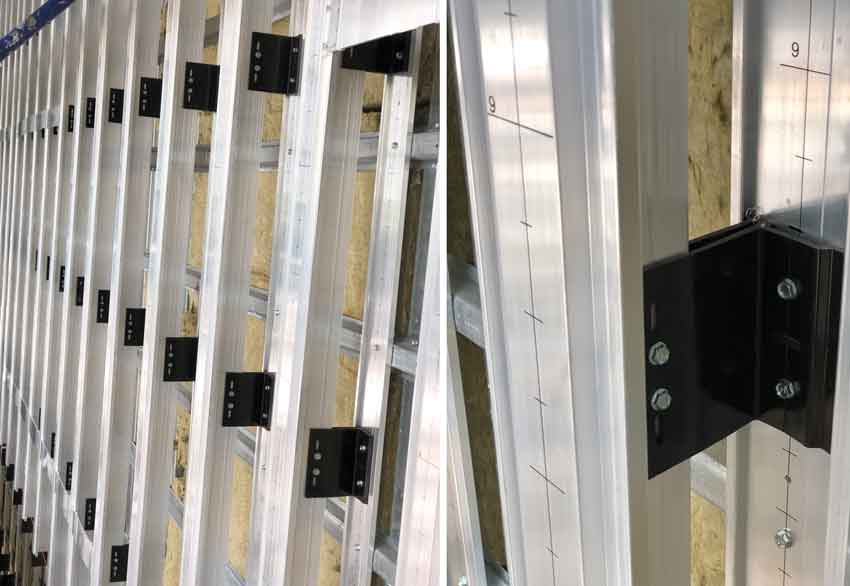
Photos courtesy of CL-TALON®
Polyamide clips with very low thermal conductance properties allow inner and outer aluminum members to be separated while controlling thermal bridging and allowing for variable depths of continuous insulation.
Testing and Code Compliance
High-performance cladding support systems often need to be tested in conjunction with the other materials in a facade assembly to demonstrate performance to meet or exceed minimum code requirements. These include NFPA 285 Standard Fire Testing, which must be done on the entire assembly, not just on individual products. Nonetheless, such high-performance systems have been shown to work exceptionally well with many common exterior wall assemblies when tested. Similarly, Air Pressure, Water Penetration, and Structural Performance testing, (ASTM E-283, ASTM E-330, ASTM E-331) has demonstrated performance beyond the levels required by building codes. This helps ensure that the cladding support system will function in normal as well as extreme weather conditions. Structural testing also indicates the ability of the cladding support system to safely transfer the imposed loads from both gravitational and wind forces affecting it to the structural members of the building.
Space Savings
One of the design and long-term financial benefits of high-performance cladding support systems is the ability to be compact and thus save space. This can come about in three ways. First, prior to installation, the compact nature of the system components require only a small space for staging and storage on site. Second, the design and strength of these systems remove the need for additional layers of cross bracing or cladding attachment rails to be installed. And third, due to the vertical and horizontal coplanar zero sightlines of the system face, the overall envelope footprint can be reduced, thus maximizing the usable/rentable square footage of a project. This thinner profile also helps to avoid encroaching upon the lot lines and air rights of any surrounding structures.
Overall, high-performance cladding support systems, are being recognized as the next generation of cladding support due to the multiple positive attributes discussed. Stewart Jeske, MS, PE, is a principal and senior glazing systems engineer at JEI Structural Engineering, says, “I’m impressed, and I think that this [type of] product will soon become the standard in the industry.” Facade contractors are weighing in too, including Erick J. Prifti of Albco, who says, “We installed a high-performance system in only three days, whereas with a traditional installation, it would have taken two weeks. We are very impressed with the speed and simplicity of the system.” All of this points to the need for architects to be aware of this technology and evaluate it for their particular projects.
Glass and Energy Performance
All occupied buildings require or desire natural daylight and views, hence the use of glass in building facades is ubiquitous. Indeed, some design approaches focus on “building with light” to create facades that capitalize on daylighting and views. The positive human effects of doing so have been documented in numerous studies that indicate the presence of glass in a building facade is essential for occupant health and well-being. There are also functional performance aspects of glass in a building facade related to occupant comfort and energy needs for artificial lighting, heating, and/or cooling in a building. Depending on the system installed, daylighting can lower energy use for lighting and related HVAC use up to 80 percent.3 In the process, the proper selection of glass can offer occupants comfortable, functional spaces that meet the program needs of the building and achieve the sought-after health and energy benefits.
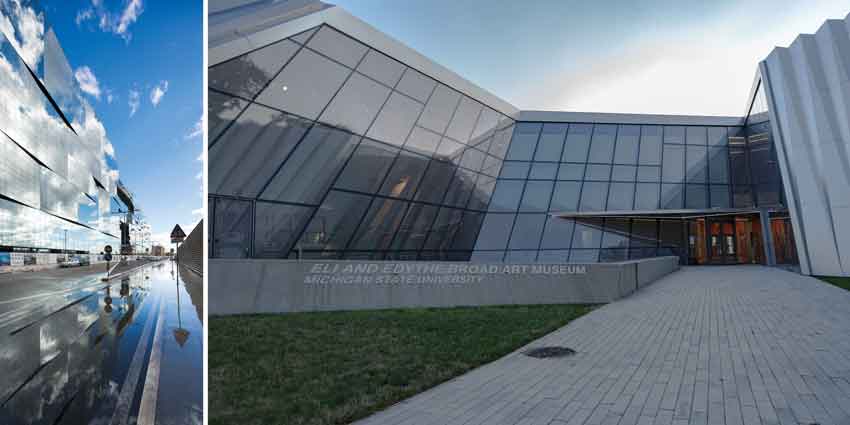
Photos courtesy of Guardian Glass/© Luc Boegly; photo courtesy of 5+1AA Alfonso Femia Gianluca Peluffo architectures (left); photo courtesy of Eli and Edythe Broad Art Museum (right)
Selecting glass for a building facade requires consideration of a number of factors, including building shape, climate, energy codes, color, reflectivity, and panel size. Such was the case for the Broad Art Museum (right) designed by Zaha Hadid Architects.
The advancement of glass technology in the past few decades has addressed all of these building and facade aspects. That now means architects who are seeking to build with light needn’t sacrifice design intent and window-to-wall ratio in the name of energy performance. High-performance, low-e glass coatings can be used to help ensure buildings are able to manage HVAC loads while still offering the aesthetic needed with clear views for occupants. In order to fully achieve the intended results, facade design that incorporates glass must consider the following:
- Building shape and orientation: Natural sunlight will hit building elevations in very different ways depending on the shape of the building and the compass orientation of each facade. Direct and indirect daylight will also enter the building differently at different times of day and during different seasons, all of which will impact energy use and occupant experience. The use of different glass coatings on different facades is one solution for managing solar heat gain, glare, and other factors in a consistent manner, regardless of these variables.
- Climate-based energy codes: The International Energy Conservation Code (IECC) identifies eight different climate zones around the United States and prescribes performance criteria specific to each climate zone. Such criteria includes glass and glazing, thus requiring architects to identify the appropriate climate zone where the building is located and select glass according to the minimum criteria of that climate zone. Whether new construction or retrofit, the design team can select a high-performance, low-e coated glass product that will deliver the needed performance characteristics most appropriate to the climate needs.
- Color and reflectivity appearance: Coated glass comes in many tints and offers different degrees of reflectivity, sometimes affected by the glass substrate used and sometimes by the coating. For new construction and retrofits, a range of clear, blue, green, and grey colors are available to suit different design schemes. For existing buildings, it is possible that the facade color and/or reflectivity of replacement glass, or new glass that is part of a new addition, needs to match or be consistent with existing glass. In those cases, large-size samples viewed at the building site will help the building team identify the best coated glass product.
- Glass panel size: While it is possible to manufacture glass in a variety of sizes and thicknesses, the equipment to add coatings has had historical size limits. That has changed with the availability of new coated glass in jumbo sizes on lites up to 217 square feet. Standard jumbo coated glass products can now be specified up to 130-by-204-inch sizes, with special orders available at 130 by 240 inches. The lites are available in 6-, 8-, or 10-millimeter thicknesses and on jumbo float glass that is clear, tinted, or low-iron.
The larger-size jumbo glass in particular has become appealing for many commercial buildings because it opens up possibilities to architects by delivering expansive views while maintaining high performance. It amplifies all of the benefits and the impact of glass facades by making indoor spaces feel more expansive and giving people inside the buildings access to extraordinary, uninterrupted views of the outside scene. With large-scale jumbo glass, the boundaries between indoors and outdoors recede, and the illusion—the connection—is complete. Further, by using clear, low-iron glass as the substrate for jumbo lites, those expansive views are free of the green tint that exists in standard glass. It also delivers clean lines, true colors, and clear views with no distractions, maximizing light transmission to bring natural light deep into interiors. Darijo Babic, director of architectural sales, North America for Guardian Glass, observes, “While the trend of architects designing projects with larger glass sizes continues to grow, we also see architects designing large projects with very high volumes of coated glass. Architects can now capitalize on 20 years of jumbo coated glass experience combined with our high-performance low-e coated glass.”
Glass product lines for commercial applications give architects a range of excellent solar control capabilities and a wide variety of colors and performance levels. Those glass products offer innovative, leading solutions for appearance and energy efficiency in facades and are commonly available through local fabricators.
Designing Expansion Joint Covers into Facades
Commercial buildings of any size require expansion joints between sections of the structure to allow a building to expand, contract, or shift laterally due to imposed forces. Those movements can come from temperature changes, causing materials to expand or contract, winds that move or sway the building, settlement over time, or seismic events. A well-designed series of expansion joints will allow sections of the building to move independently of each other without damaging either the structure or the finish materials.
In addition to allowing for movement, expansion joint covers also need to be able to insulate and protect the joint opening from outside elements. If water or moisture make their way into the joint opening, then the building could be susceptible to leaking, moisture damage, mold, or other deterioration that could cause failure. Therefore, metal covers with a water and vapor barrier installed behind the cover are common, as are fully watertight solutions that fit into a joint opening. Similarly, if airborne dust, dirt, or other objects get in behind the expansion joint cover, then it may not function properly since the anticipated movement or sliding of components could be impaired. Hence the expansion joint cover needs to seal against such penetration of foreign matter as well.
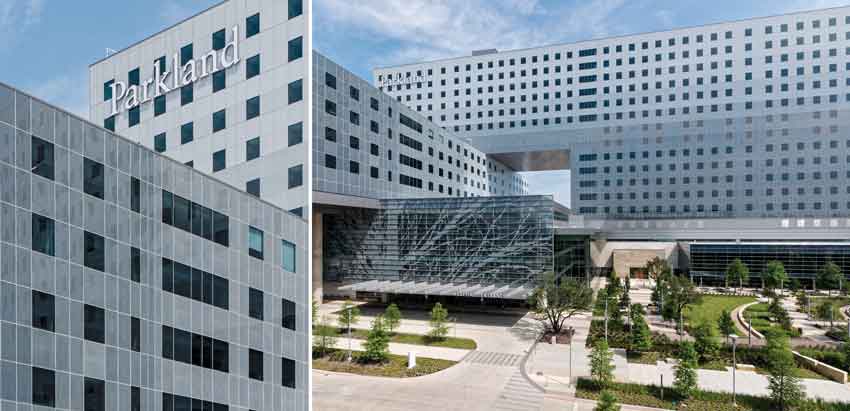
Photos courtesy of Construction Specialties
A design challenge at Parkland Hospital in Dallas was determining how to integrate the expansion joint covers directly into the facade system. This involved incorporating the glass finish and accommodating movement all while being water- and airtight to maintain building performance.
From a design standpoint, architects often look for ways to hide or integrate expansion joint covers into the overall design of the facade. Fortunately, such integration is entirely possible without compromising either performance or aesthetics. Manufacturers routinely provide multiple options for covers that can be infilled with the same materials as the facade thus creating a continuous appearance. The metal of the expansion joint cover itself can also be custom colored to match a building’s facade and become virtually undetectable.
When an expansion joint cover type is identified that meets the aesthetic criteria for a project, architects can then work with manufacturers to verify that the performance criteria is met. Some provide considerable technical assistance and, when applicable, they can conduct cycle testing on a joint cover to verify their performance. From that standpoint, architects should have confidence that the solution they specify will both perform well and blend into the overall facade design in a minimally invasive way.
Kevin Smith, PE, is the engineering manager at Construction Specialties and provides technical assistance to architects on a regular basis regarding expansion joint covers. He points out that “a successful building design requires intricate detailing and integration of the expansion joint cover system early in the process. This will ensure a fully weathertight system and minimum interruption in the architect’s vision. The goal is to provide a minimally invasive solution that meets the performance standards of the building envelope.” This indicates that manufacturers care as much about meeting the design requirements of expansion joints as they do about their performance.
Controlling Air with Facade Louvers
Building facades often require a precise means to provide intake for outside air as well as exhaust air for HVAC systems. While the size and locations of such intake or exhaust openings are determined in concert with mechanical engineers, it is typically the architect who determines the aesthetics and how the louvers integrate with the facade. Commonly, the solution lies in selecting architectural louvers that allow for proper airflow while preventing water and even wind-driven rain from entering plus providing frame joinery that is integral to the adjacent facade. Fortunately architectural louvers, like expansion joint covers, can be designed to meet these performance needs and be readily customized to integrate into virtually any building facade.
Louvers are available in a range of performance categories, including storm-resistant, extreme-weather-resistant, impact-rated, acoustically rated, drainable, non-drainable, operating, and even blast-resistant selections. But it’s not enough to just pick from one of these different louver types when specifying them. The louver system also needs to be independently tested and certified by the Air Movement and Control Association (AMCA). This is the third-party testing agency for the louver industry that provides a means for manufacturers and products to have consistent and accurate published performance data. No louver model should be used without the appropriate AMCA seal located on the manufacturer’s technical data sheet. In particular, AMCA Publication 511 dictates the proper presentation of data and other required technical procedures for certification of air-control devices under the AMCA Certified Ratings Program. ANSI/AMCA Standard 500-L1 is the basis of this program and outlines the testing protocols of louvers. It includes a laboratory method of testing louvers for ratings in the categories of Air Performance, Point-of-Beginning Water Penetration, and Wind-Driven Rain. In addition, Free Area is included as a calculation, rather than a test, but is also a crucial performance indicator.
Aesthetically, architectural louvers offer considerable design flexibility. Louvers can be installed to be oriented either horizontally or vertically. They can be custom curved, outfitted with creative blade color patterns, use varying blade depths, or include asymmetrical blade frequencies and staggered blade placement. LED lights can even be added to create a dramatic or subdued accent. Louvers can be selected and specified in a range of profile styles with different appearances across the louver blade areas. Many are available with a full palette of color options, including color shifting, wood grain, and faux stone finishes. There is even at least one product that offers a louver hidden by perforated sheet, allowing all the air movement, security, and sight screening of standard louvers but with a fresh modern appearance.
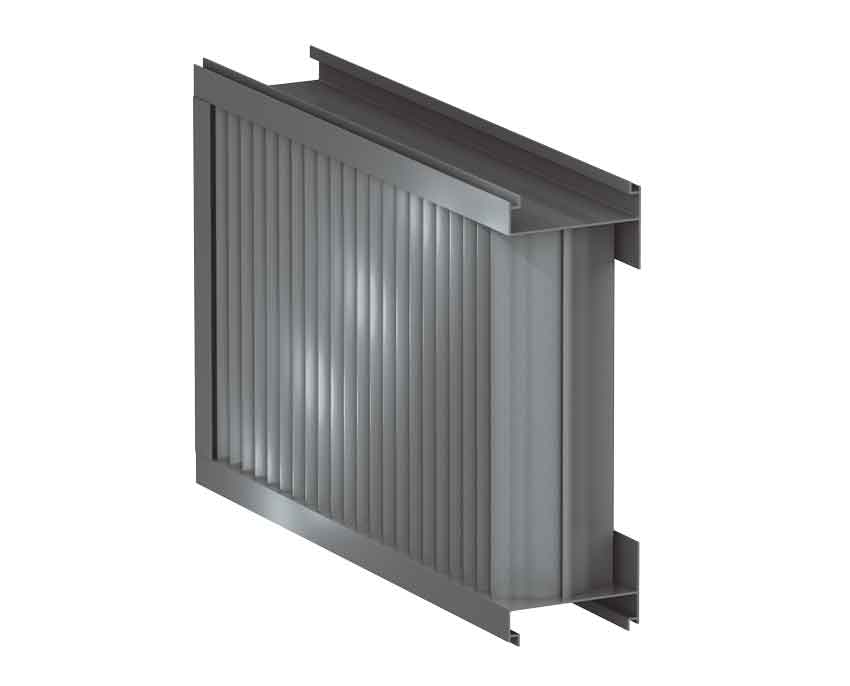
Image courtesy of Construction Specialties
Storm-resistant vertical mullion louvers, such as the one shown here, are AMCA tested and certified for levels of air performance, water penetration, and resistance to wind-driven rain.
Conclusion
Building facades provide a wealth of design opportunities with a wide range of materials and systems to choose from. The decisions made related to the facade impact the exterior design of the building and the performance needs to integrate with the structure and control wind, water, sun, heat, air, and the normal movement due to expansion and contraction. By keeping up to date with manufactured products, innovations, and creative applications, architects can design vibrant, resilient buildings that perform more than skin deep.
END NOTES
1Building Facades. 2030 PALETTE. Architecture 2030. Web. 27 Sept. 2018.
2“Thermal Analysis of CL-TALON 300 Cladding Support System.” Morrison Hershfield. 16 July 2018.
3The Power of Daylighting Systems in Building Design. Ciralight. Web. 27 Sept. 2018.
Peter J. Arsenault, FAIA, NCARB, LEED AP, is a nationally known architect, consultant, continuing education presenter, and prolific author advancing building performance through better design. www.pjaarch.com, www.linkedin.com/in/pjaarch



